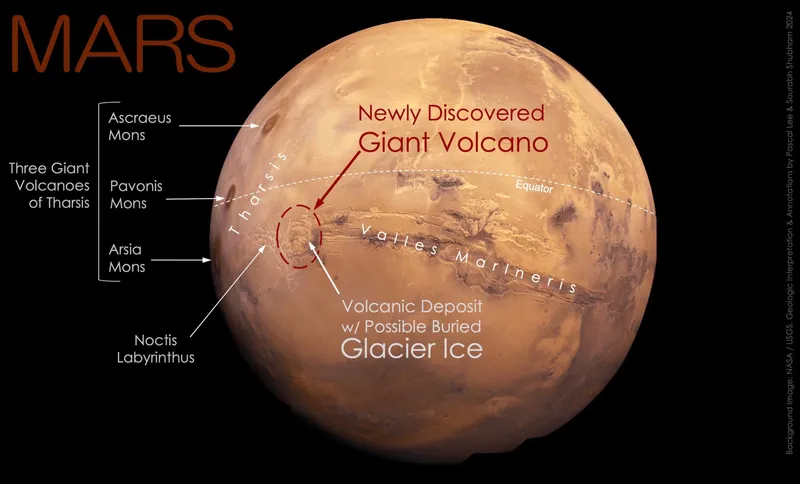Volcano Hidden in Plain Sight! Another Martian Discovery Rocks Our World
In a revelation that has stirred the space exploration sector and Martian enthusiasts alike, astronomers have unveiled the discovery of a colossal volcano on Mars, now named the Noctis Volcano.
Mars, the Red Planet, continues to surprise us with hidden secrets. In a discovery that's truly out of this world, astronomers have unearthed a colossal volcano that's been lurking in plain sight for decades! Buckle up, space enthusiasts, because this volcanic behemoth is about to erupt... with information, that is.
A Martian Mammoth Unearthed
The newly identified volcano, provisionally named "Noctis" after the Latin word for "night" due to its location near the "Labyrinth of Night" region, boasts a staggering footprint. Clocking in at a width of 450 kilometers (280 miles) and a height exceeding 9,000 meters (29,600 feet), Noctis rivals some of Mars' most prominent volcanic giants. This fiery titan has been hiding in the shadows of Mars' Tharsis volcanic province, a region already brimming with colossal volcanoes like Olympus Mons, the undisputed heavyweight champion of the solar system.
A Mystery Unveiled

The intrigue surrounding the Noctis Volcano lies not just in its size but in its ability to remain undetected in plain sight for so long. The structure's observation dates back to 1971, with several Mars-orbiting spacecraft capturing images over the decades. Yet, it was the recent detailed analysis using data from missions like NASA's Mars Reconnaissance Orbiter and the European Space Agency's Mars Express that revealed the true nature of this geological behemoth.
The Noctis Volcano does not present the conventional cone shape typical of terrestrial volcanoes. Instead, its history of deep fracturing and erosion has sculpted it into a complex structure. Features such as an arc of high mesas marking the central summit area, a caldera remnant, and extensive lava flows and pyroclastic deposits outline its volcanic origins. Moreover, the discovery of possible glacier ice near its base adds another layer to its mystique, suggesting recent volcanic activity and a dynamic geological past.
Why Did We Miss It?
The question of how such a monumental feature could evade definitive identification for so long can be attributed to a combination of factors. The extensive erosion and alteration of the volcano's structure over millions of years obscured its volcanic characteristics, making it blend seamlessly with the surrounding Martian landscape. It was only through the synthesis of decades of imaging and topographic data that its true nature was uncovered.
Why This Discovery is a Big Deal
This discovery is not just a testament to the evolving techniques in planetary science but also opens new doors for understanding Mars' geologic and climatic history. Furthermore, the presence of possible glacial ice deposits near Noctis' base, hinted at by subtle topographical features, adds another layer of intrigue. Water ice is a crucial ingredient for life as we know it, making Noctis a prime candidate for future exploration missions searching for potential biosignatures, the chemical fingerprints of past or present life.
A Step Forward in Martian Exploration
The unearthing of the Noctis Volcano on Mars serves as a vivid reminder of the vast unknowns still to be explored in our solar system. It underscores the importance of continued investment in space exploration and the potential for unexpected discoveries that challenge our understanding of familiar worlds. As we stand on the cusp of new horizons, the story of the Noctis Volcano inspires not just scientists but all of humanity to look closer, dig deeper, and dream bigger in the endless quest for knowledge beyond our Earth.
Edited by Rahul Bansal







